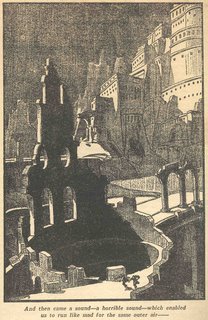
Here is a rare and precious experience. You have to love ebay.
This is a copy of Lovecraft's first book and has Hoag's signature! S. T. Joshi relates the story thus:
Hoag was a very old man and a poet (born 1831 in Troy, NY). Lovecraft began writing poetical birthday odes to Hoag in 1918 to everyone's delight. Hoag pushed to have his verse put into a book, and enlisted Lovecraft to edit it. LOveman and Morton were enlisted to help. LOvecrfat commissioned Loveman to get $1 per 24 lines edited (1/3 the going rate). Lovecraft had no money, so Hoag financed the project. In April, the galleys came in, and the book bound shortly thereafter. Lovecraft refused payment and received 20 copies of the book instead. Lovecraft wrote the introducyion, and while HPL was usually blunt with criticism, he gushed over Hoag's lifetime work. Joshi read the verse and found it weak. The book has 6 Lovecraft odes to Hoag, also. Hoag died in 1926 at age 96. (1)

This says "To Charley and mary Wilbur, family // Please accept compliments of the author. J. C. Hoag. // Vista Buena. Junne 14, 1923."
Ebay anouncemnet read: This is one of H. P. Lovecraft's first books. It includes--at the very least-- six of his poems and his "Biographical and Critical Preface" of the author. The book is: The Poetical Works of Jonathan Hoag, Privately Printed Author's Edition, 1923, first edition. This book measures 9 1/4" x 5 3/4" and is 72 pages. It is in Near Fine condition with some gentle wear to the binding, some inevitable age-darkening to the pages, and some foxing to the first few pages. Hoag was a friend of Lovecraft, and this Hoag poetry collection concludes with poems by Lovecraft and others to celebrate Hoag's 87th-92nd birthdays. Lovecraft also has written the five-page introduction, and, reference materials indicate that two of the book's poems attributed to Hoag (i.e., "To the American Flag" and "Death") were actually written by Lovecraft and that, in addition, Lovecraft was this book's editor. There is a frontispiece photograph of Hoag, who has inscribed and signed the book on one of the blank front pages (please see image #2 below). There is no former owner's bookplate inside, no writing inside (except Hoag's), the top page edge is gilt, and all pages are firmly attached to the very-solid spine. This book is included in "Collected Books-2002" by the Ahearns.

(1) H. P. Lovecraft: A Life, 1996, p.292
































